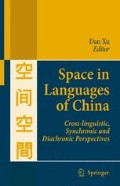Location is an important category of space. In Chinese, from the times of Oracle-bone inscriptions to now, one of the means used to indicate space or location is the demonstrative pronoun. But before the medieval period there only was one kind of demonstrative pronoun which can be both used to demonstrate person and location. During the medieval period, an evolution occurred in the Chinese demonstrative pronoun system. In the pre-modern period Chinese had developed a system of inessive demonstrative pronoun, such as zhèlĭ 这里 ‘here’, nàlĭ 那里 ‘there’, zhèbiān 这边 ‘this side’, nàbiān 那边 ‘that side’, which are special demonstrative pronouns used only to indicate space and location. This paper focuses on the evolution and tries to answer the following questions: how did the evolution occur? What is the reason of the evolution?
Access this chapter
Tax calculation will be finalised at checkout
Purchases are for personal use only
Preview
Unable to display preview. Download preview PDF.
References
Chén Wénjié 陈文杰. (1999). Cóng zǎoqī hànyì fódiǎn kàn zhōnggǔ biǎo fāng suǒ de zhǐshì dàicí 从早期汉译佛典看中古表方所的指示代词 [A survey of instructive pronoun for location and direction in Chinese Buddhist translations of Medieval times]. Gǔ Hànyǔ Yánjiū 古汉语研究 4. Chángshā.
Giles, Herbert Allen. (1877). Record of the buddhistic kingdoms (translated from Chinese). Shanghai: Kelly & Walsh.
Lǐ Chóngxīng 李崇兴. (1992). Chùsuǒ cí fāzhǎn lìshǐ de chūbù kǎochá
处所词发展历史的初步考察 [Initiative Inspections on the Development of Nouns of Locality]. In Hú Zhú’ān (Ed.), Jìndài Hànyǔ Yánjiū近代汉语研究. Beijing: Shāngwù Yìnshūguǎn.
Lǚ Shūxiāng 吕叔湘. (1942-44/1990). Zhōngguó wénfǎ yàolüè 中国文法要略 [A Summary of Chinese Grammar]. In Lǚ Shūxiāng Wénjí吕叔湘文集 I. Beijing: Shāngwù Yìnshūguǎn.
Hopper, P., & Traugott, E. C. (1993). Grammaticalization. Cambridge: Cambridge University Press.
Mather, Richard B. (2002). A New Account of Tales of the World (translated with introduction and notes by. Ann Arbor). Center for Chinese Studies, University of Michigan.
Ōta Tatsuo 太田辰夫. (1958/2003). 中国語歷史文法[A Historical grammar of Modern Chinese]. 江南書院. (Chinese translation by Jiǎng & Xu). Beijing: Beijīng Daxué Chūbanshe.
Shimura Ryōji 志村良治. (1982/1995). 中国中世語法史研究[A Study on Grammar of Medieval Chinese]. 三冬社. (Chinese translation by Jiāng & Bái). Beijing: Zhōnghuá Shūjú.
Waley, Arthur. (1996). The Book of Songs. New York: Grove Press.
Wāng Róngpéi 汪榕培, & Rén Xiùhuà 任秀桦. (1994). Shijīng Yīng Yì 诗经英译 [The Book of Poetry]. Shěnyáng: Liáoníng Jiàoyù Chūbǎnshè.
Zhāng Yùjīn 张玉金. (2001). Jiǎgǔwén Yǔfǎ Xué 甲骨文语法学 [Study on Grammar of the Oracle-Bone Inscriptions]. Beijng: Xuélin Chūbanshe.
Zhāng Yùjīn 张玉金. (2004). Xīzhōu Hànyǔ Yǔfǎ Yánjiū 西周汉语语法研究 [Study on Grammar of the West Zhōu]. Beijing: Shāngwù Yìnshūguǎn.
Author information
Authors and Affiliations
Editor information
Editors and Affiliations
Rights and permissions
Copyright information
© 2008 Springer Science + Business Media B.V
About this chapter
Cite this chapter
Zhu, Q., Chen, W. (2008). The Inessive Structure in Archaic and Medieval Chinese: An Evolutionary Study of Inessive Demonstrative Uses From Archaic to Early Modern Chinese. In: Xu, D. (eds) Space in Languages of China. Springer, Dordrecht. https://doi.org/10.1007/978-1-4020-8321-1_11
Download citation
DOI: https://doi.org/10.1007/978-1-4020-8321-1_11
Publisher Name: Springer, Dordrecht
Print ISBN: 978-1-4020-8320-4
Online ISBN: 978-1-4020-8321-1
eBook Packages: Humanities, Social Sciences and LawSocial Sciences (R0)

